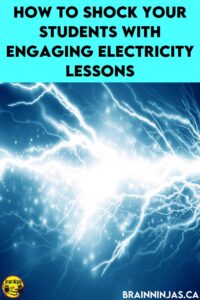
As ninjas, we are always looking for ways to teach our students new skills like problem-solving and critical thinking without the students KNOWING we are teaching them skills like problem-solving and critical thinking. We love project-based learning, and electricity lessons are a great unit to practice some hands-on learning.
We give our students just enough information to be safe and get working on a project. Our students get so wrapped up in their projects that they don’t even notice they are learning. That’s why we’re the Brain Ninjas, and that’s why you need to try it, too!
If you want to try project-based learning, but aren’t sure where to start, read The Reasons for Project-Based Learning. It is filled with helpful tips to get you going with projects in your classroom. If you struggle with managing Project-Based Learning, this post might be helpful How to Keep Students Accountable During Project-Based Learning.
You can also get our free Tips & Tricks for Project-Based Learning by signing up for our email list. It can also be found in our Resource Library, along with many other general classroom forms to help you organize your classroom.
As part of our science curriculum, students in Alberta have to design and build devices that use electricity. We create an electrical trivia game. The best part is that students ENJOY it! They get a chance to be super creative, and we get to check if they understand how circuits work.
Try Out These Electricity Projects
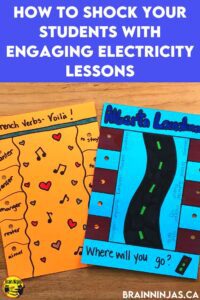
Design an Electrical Game Board: We challenged them to design a board game that would use an electrical circuit to check if an answer to a trivia question was correct or not. Some students thrived (and we’re not going to lie-some cried). But after doing this task every year for the past four years, it has a 99% success rate. The 1%? Despite our ninja superpowers, we don’t actually control electricity. You can get all the student pages and the lesson plan in our store. It is also full of examples for students to use for inspiration.
Students collect questions and their answers. Then they design a game board where connecting a circuit to the answer and the question will result in a correct answer lighting a light bulb.
Find the Design an Electrical Game Board in our TpT Store ($USD) and BN Shop ($CAN).
Electricity Lessons to Get the Basics
There are several different concepts, so we designed an entire set of electricity lessons so students can learn all the basics and still have fun.
Electricity Lessons and Activities
This is a set of lesson plans designed to help students gain background knowledge and develop concept vocabulary for the unit.
Find the Electricity Lessons and Activities in our TpT Store ($USD) and BN Shop ($CAN).
Electricity and Magnetism
This helps students make the connection between electricity and magnetism.
Find the Electricity and Magnetism Lesson in our TpT Store ($USD) and BN Shop ($CAN).
Switches
Have your students explore and design different types of switches with these hands-on activities.
Find the Switches lesson in our TpT Store ($USD) and BN Shop ($CAN).
Electricity Safety Interactive Game
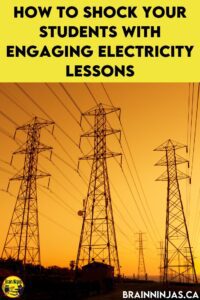
Going over the basic safety rules before students can use their equipment is a must, but it can be pretty boring to just go through a long list of rules. That’s why we came up with an interactive game where students deal with specific situations that involve electricity. It’s similar to a “choose your own adventure” style book, but instead of a story, students navigate through different understandings about how to interact with electricity. It only takes a few minutes to set up for students to use. Students can play it over and over again to practice.
Find the Electricity Safety Interactive Game in our TpT Store ($USD) and BN Shop ($CAN).
Electricity Challenges for Problem Solvers
Electricity STEM Challenges
In this series of challenges, students use what they have learned about electricity to solve different problems. It comes with planning pages and suggestions (or hints for the teacher), but we love doing these with our students.
Students are so engaged and love trying out their different ideas. This is a great way to get your students working in small groups for short periods of time.
You can read about more critical thinking challenges that use different concepts in our blog post called How to Leverage Critical Thinking Challenges to Your Advantage. We use these activities to teach concepts by letting students try to figure them out before teaching them the specifics. Students remember things so much better when they can create the meaning themselves.
Find the Electricity STEM Challenges in our TpT Store ($USD) and BN Shop ($CAN).
Electricity Task Cards
Have your students practice reading circuit diagrams and thinking about what it takes for a circuit to work with this set of twenty-four task cards. They are available in a paper version and a digital version that uses Google Slides.
These cards do have a bit of reading, but they can be completed individually or in students’ groupings all the way up to the whole class. Instructions, suggestions, student answer recording pages and answer keys are all included in this product as well. Our students even helped with this one as they came up with some of the questions based on the circuit drawings.
Find the Electricity Task Cards in our TpT Store ($USD) and BN Shop ($CAN).
Electricity Interactive Review Game
When you’ve finished teaching all the electricity lessons and want to review the concepts, you can use this interactive game that uses Google Slides. It is set up similarly to Jeopardy, where students select questions from categories, but we’ve never requested that students answer in the form of a question. Each of the questions links directly to its answer, so students can even self-check if they are working individually.
Find the Electricity Interactive Review Game in our TpT Store ($USD) and BN Shop ($CAN).
Support your electricity lessons with these tools.
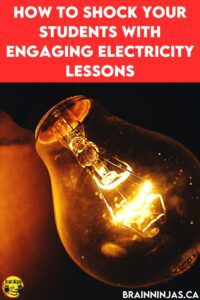
Electricity Reading Passages
This set of ten reading passages covers all the basic electricity and magnetism concepts. They come in a paper format as well as a digital format that can be used with text-to-speech readers.
Find the Electricity Reading Passages in our TpT Store ($USD) and BN Shop ($CAN).
Electricity Circuit Diagrams Symbols Posters
Students enjoy creating drawings of circuit diagrams. Use this set of posters for students to refer to when they are working through a unit on electricity. Since different symbols are used for different purposes, the posters feature a variety so that you can use the symbols specific to your class.
Once your students are familiar with the different symbols, they can use them in their planning for creating different circuits and for experimenting with electricity (safely, of course!)
Find the Electricity Circuit Diagram Symbols Posters in our TpT Store ($USD) and BN Shop ($CAN).
Get the bundle!
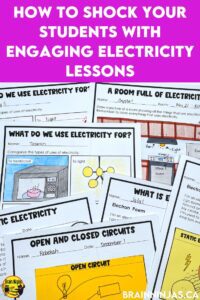
And, if you think you’d like to get all of our electricity lessons all at once, you can purchase the bundle at a discount (plus, you’ll get everything we add in the future, too!). It includes all the lessons and activities mentioned above.
We even have a set of Electricity-themed Weekly Reading Comprehension activities that focus on electricity concepts:
Eclectic Electricity on TpT ($USD) or our BN Shop ($CAN)
Electric Eels on TpT ($USD) or our BN Shop ($CAN)
Internet Data Centres on TpT ($USD) or our BN Shop ($CAN)
Lightning on TpT ($USD) or our BN Shop ($CAN)
Electric Cars on TpT ($USD) or our BN Shop ($CAN)
You can use your science content to help teach reading concepts.
Find the Electricity Concepts Science Lessons Bundle in our TpT Store ($USD) and BN Shop ($CAN).
What about some online electricity lessons?
We love to let our students use actual elements to create electrical circuits, but things happen, so we always like to have a backup of activities just in case.
Primary Homework Help has a great page of electricity games that reinforce the learning concepts.
ElectroCity is a fun simulation game that allows students to explore renewable resources while balancing the economy of a city. This one is often a favourite of our students, but we don’t let them log in and save their games. We just play for fun.
What about some offline electricity activities?
You’ll need some supplies if you expect your students to create and use simple circuits. Most school districts have access to a distribution center with science materials designed for the classroom. Your school probably has many of these materials. You just have to track them down.
Your basic kits should include:
- D cell batteries
- wires (with exposed ends or alligator clips)
- battery holders
- bulb holders
- small bulbs that fit the holders
- (optional) containers to hold the materials
Once you have the basics, collect some materials that make the unit more interesting. Items like resistors, switches, motors or even doorbells (we warned you that they are loud). Collect metal paper clips, clothespins, tin foil and electrical tape to have a well-rounded set of supplies.
Ninja Note: Teach your students to disconnect their batteries between tests to preserve their power. Store your batteries so they don’t run in series and drain the power or, worse, cause a short circuit. Even though they aren’t powerful enough to shock you, they can start a fire if stored incorrectly, or they can spill the chemicals inside. Nobody needs battery acid on their stuff!
Static Electricity Tag
Get a balloon and get it all staticky by rubbing on a sweater or someone’s hair. Students move around the room, passing the balloon without using their hands-only with static electricity.
Electromagnets
Honestly, these are supposed to be so easy to create, but they can be difficult. We’ve learned an iron nail with thin copper wire wrapped around the nail at least 100 times will create an electromagnet when it is hooked up to nine volts or more. This will be enough to pick up a metal paper clip.
However, creating a simple circuit and placing it next to a compass will show students how an electric current can change the magnetic pull, so we recommend this much simpler activity.
Steve Spangler
This incredible science teacher has gained notoriety by appearing on the Ellen Degeneres show, but before that, he was a science teacher. His website is full of great experiments AND the best part is there are videos, so if your experiment doesn’t work out, you can still show students the video so they can see what the results were supposed to be. He’s also on Instagram.
Create a Student Challenge
Ask your students to do some research to find electricity experiments. Do them together in class (especially for safety reasons) or let them do them at home with parental supervision. Some of our favourite things to do have come from our students finding things in books or online for us to try.
Do you teach elementary science?
If you teach science, you might find these posts helpful:
- How to Grow A Healthy Classroom
- All Our Engaging Weather Lessons All in One Place
- How to Learn About Wetlands Without A Pond
- How to Work Through the Design Process
- Astronomy Lessons That Are Out of This World
- 15 Simple Machines Activities that Will Hook Your Students
- Foster Environmental Stewardship in the Classroom
- Create These 5 Fantastic Devices That Move
- How to Escalate Your Chemistry Experiments
We’re trying to make life easier for our fellow teachers, so let us know what you need!
What other activities do you like to do with your class using electricity? We’d love to add it to our list so other teachers can benefit as well.








you guy have to be kinding me this is the most coolest thing
the review game for powerpoint would be awesome for us low-tech teachers!
Thanks for your comment Heidi! We’ll add this to our list of things to add. Thanks for your feedback. 🙂